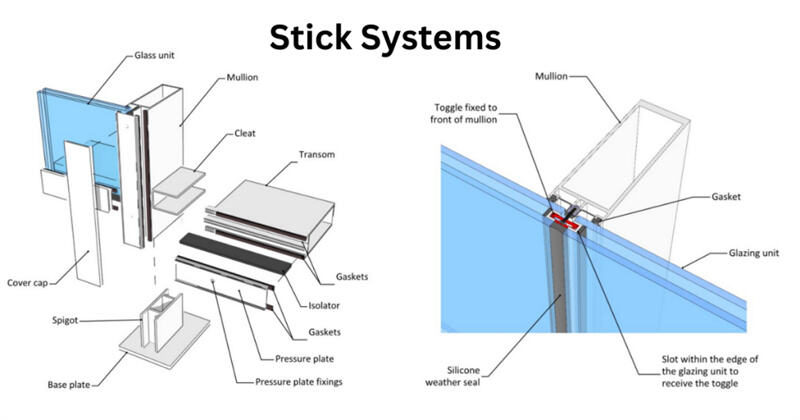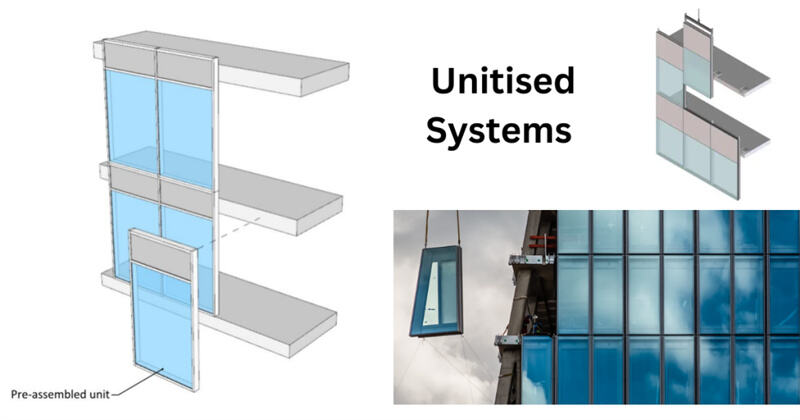The selection of the appropriate curtain wall system is a decisive move in designing and building of contemporary buildings. The two main systems, which are stick and unitized, have their own pros and cons. The system is the one that will best fit your requirements in the project. We discuss the major differences below to assist in your decision.
Stick Curtain Wall Installation Is Flexible but the Construction Period Is Long
Stick curtain wall systems are built in bits on-site. The mullions (vertical frames) and transoms (horizontal frames) are fitted in firstly and then the glazing or panel infills. The approach has a high level of flexibility.
A notable benefit is that there is the capability of making adjustments during the installation. This may be especially useful in projects of complicated geometry or difficult access sites where large units built in advance would be hard to move. It can also be changed easily in case, there are last-minute changes.
Nonetheless, such flexibility is at the expense of time. As the whole system is constructed on the field, the operation highly relies on the weather conditions and demands a more extended labor force on the field. This contributes to a duration in construction unlike the prefabricated variations. Moreover, a higher percentage of work at the site may also raise the risks of quality variations and necessitate strict on-site control in order to maintain the performance criteria.

Unitized Curtain Wall Is Efficient but the Cost Is Slightly Higher
Unitized curtain wall systems are giant and pre-fabricated modules manufactured in a factory controlled setting. The full units including the frame, glass and other parts are then delivered to the location and just attached to the building structure.
The main advantage of this solution is that its efficiency is increased significantly, and a reduced time is needed on-site to construct the building. Since the modules are produced in the factory, quality control is enhanced resulting in increased accuracy and overall performance of air and water infiltration. The quicker construction method is less prone to weather setbacks and less labor is needed to establish on-site, which may prove a significant benefit in urban constrained locations or areas with less construction periods.
The major disadvantage is the increased initial cost. Specialist factory machinery, transport of large modules and a more complicated design and engineering stage also adds to the increased initial outlay. In certain projects this cost increase can be compensated by the savings in the cost of a much shorter construction schedule that means the project is completed and occupied sooner.

Applicable Project Types and Budget Considerations
The decision on whether to use a stick or unitized curtain wall will eventually depend on the size of your project, schedule, cost, and the intricacy of the design.
Stick systems have frequently been found in favour of:
Smaller buildings or low-rise.
Projects, in which the complexity of design or the site limitations necessitate maximum flexibility.
Cases that have a constrained initial budget, and where a longer stay on-site duration is feasible.

Unitized systems are normally suitable in:
Tall commercial towers and high-rise buildings on a large scale.
Growths in which it is important to have minimum time on-site construction.
Projects are situated in high-density urban areas where there is not much storage space of the materials and labor is on site.
Budget wise, a comprehensive life-cycle analysis of cost is advisable. Stick systems, though possibly less expensive to begin with in terms of material, can also carry a high cost of soft costs due to the lengthy work time and the work period. The increased cost of factory fabrication of unitized systems can offset through speed, lower on-site overhead, and possibly lower long-term maintenance of their sealed, high-quality units that are factory-sealed.
You can then choose the curtain wall system that will provide the best value and performance to your building at a reasonable cost and weighing the trade-offs between flexibility, speed, cost, and project specific needs.

 EN
EN
 FR
FR
 DE
DE

